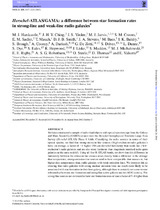| dc.contributor.author | Hardcastle, M.J. | |
| dc.contributor.author | Ching, J.H.Y. | |
| dc.contributor.author | Jarvis, Matt | |
| dc.date.accessioned | 2016-10-29T10:19:45Z | |
| dc.date.available | 2016-10-29T10:19:45Z | |
| dc.date.issued | 2013 | |
| dc.identifier.citation | Hardcastle, M.J. et al. (2013). Herschel-atlas/Gama: a difference between star formation rates in strong-line and weak-line radio galaxies. Monthly Notices of the Royal Astronomical Society, 429: 2407–2424 | en_US |
| dc.identifier.issn | 0035-8711 | |
| dc.identifier.uri | http://hdl.handle.net/10566/2463 | |
| dc.identifier.uri | http://dx.doi.org/10.1093/mnras/sts510 | |
| dc.description.abstract | We have constructed a sample of radio-loud objects with optical spectroscopy from the Galaxy
and Mass Assembly (GAMA) project over the Herschel Astrophysical Terahertz Large Area
Survey (Herschel-ATLAS) Phase 1 fields. Classifying the radio sources in terms of their
optical spectra, we find that strong-emission-line sources (‘high-excitation radio galaxies’)
have, on average, a factor of ∼4 higher 250-μm Herschel luminosity than weak-line (‘lowexcitation’)
radio galaxies and are also more luminous than magnitude-matched radio-quiet
galaxies at the same redshift. Using all five H-ATLAS bands, we show that this difference in
luminosity between the emission-line classes arises mostly from a difference in the average
dust temperature; strong-emission-line sources tend to have comparable dust masses to, but
higher dust temperatures than, radio galaxies with weak emission lines. We interpret this as
showing that radio galaxies with strong nuclear emission lines are much more likely to be
associated with star formation in their host galaxy, although there is certainly not a one-to-one
relationship between star formation and strong-line active galactic nuclei (AGN) activity. The
strong-line sources are estimated to have star formation rates at least a factor of 3–4 higher than those in the weak-line objects. Our conclusion is consistent with earlier work, generally carried
out using much smaller samples, and reinforces the general picture of high-excitation radio
galaxies as being located in lower-mass, less evolved host galaxies than their low-excitation
counterparts. | |
| dc.language.iso | en | en_US |
| dc.publisher | OUP | en_US |
| dc.rights | Copyright, The Authors | |
| dc.source.uri | http://dx.doi.org/10.1093/mnras/sts510 | |
| dc.subject | Astronomy | |
| dc.subject | Galaxies | |
| dc.subject | Radio continuum | |
| dc.subject | Galaxy and Mass Assembly (GAMA) | |
| dc.subject | Herschel Astrophysical Terahertz Large Area Survey (Herschel-ATLAS) | |
| dc.title | Herschel-atlas/Gama: a difference between star formation rates in strong-line and weak-line radio galaxies | en_US |
| dc.type | Article | en_US |
| dc.description.accreditation | Web of Science | |

